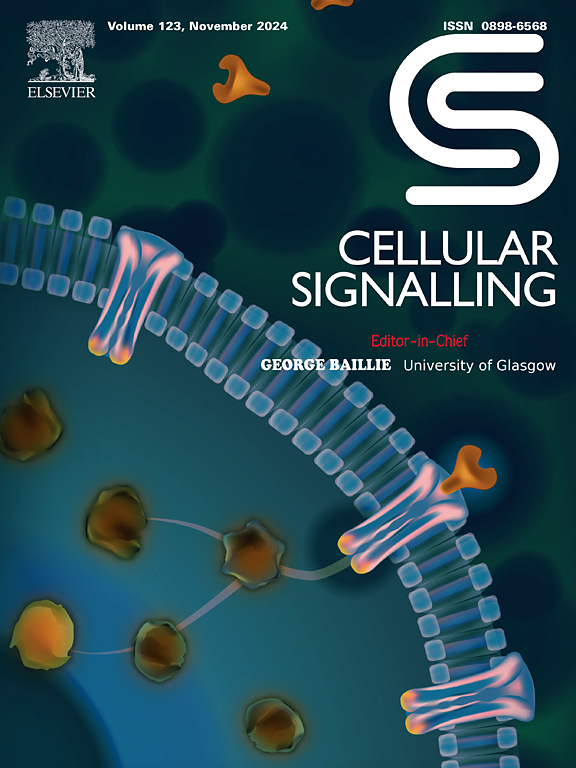PSMC2 upregulation enhances epithelial-to-mesenchymal transition in glioblastoma via activating AKT/GSK3β/β-catenin axis
IF 4.4
2区 生物学
Q2 CELL BIOLOGY
引用次数: 0
Abstract
Glioblastoma multiforme (GBM), a grade IV brain tumor, remains one of the most aggressive and difficult-to-treat cancers, emphasizing the urgent need for novel therapeutic targets. The dysregulation of the unfolded protein response, particularly involving the proteasomal pathway, contributes significantly to the pathogenesis of GBM. Proteasome 26S subunit ATPase 2 (PSMC2) has recently been identified as a potential factor in carcinogenesis; however, the molecular mechanisms involved remain unclear. In this study, we found significantly high expression of PSMC2 in GBM, with increased levels associated with an unfavorable prognosis. PSMC2 knockdown in GBM cell lines reduced proliferation, impaired migration, and induced apoptosis, while its overexpression enhanced epithelial-to-mesenchymal transition (EMT) related marker expression. Further, the tumorigenic effect of PSMC2 was confirmed in vivo as PSMC2 knockdown reduced the tumor volume and weight. Mechanistically, PSMC2 promoted malignancy via nuclear localizing of β-catenin by activating AKT/GSK3β/β-catenin axis, with AKT-mediated inhibitory phosphorylation of GSK3β enabling β-catenin activation. Besides, we used Lithium chloride to induce GSK3β phosphorylation which reversed the effects of PSMC2 knockdown, further validating this pathway. These findings demonstrate that PSMC2 drives GBM progression by regulating the AKT/GSK3β/β-catenin axis, positioning it as a promising biomarker and therapeutic target for GBM.

PSMC2上调通过激活AKT/GSK3β/β-catenin轴促进胶质母细胞瘤上皮向间质转化
多形性胶质母细胞瘤(GBM)是一种IV级脑肿瘤,仍然是最具侵袭性和最难治疗的癌症之一,强调迫切需要新的治疗靶点。未折叠蛋白反应的失调,特别是涉及蛋白酶体途径的失调,在GBM的发病机制中起着重要作用。蛋白酶体26S亚基atp酶2 (PSMC2)最近被确定为致癌的一个潜在因素;然而,涉及的分子机制尚不清楚。在本研究中,我们发现PSMC2在GBM中显著高表达,其水平升高与不良预后相关。在GBM细胞系中,PSMC2敲低可减少增殖、阻碍迁移并诱导凋亡,而其过表达可增强上皮-间质转化(EMT)相关标志物的表达。此外,PSMC2的致瘤作用在体内得到证实,PSMC2的敲除减少了肿瘤的体积和重量。机制上,PSMC2通过激活AKT/GSK3β/β-catenin轴,通过β-catenin的核定位促进恶性肿瘤,AKT介导的GSK3β抑制磷酸化使β-catenin活化。此外,我们使用氯化锂诱导GSK3β磷酸化,从而逆转PSMC2敲低的作用,进一步验证了这一途径。这些研究结果表明,PSMC2通过调节AKT/GSK3β/β-catenin轴驱动GBM进展,将其定位为GBM的有前景的生物标志物和治疗靶点。
本文章由计算机程序翻译,如有差异,请以英文原文为准。
求助全文
约1分钟内获得全文
求助全文
来源期刊

Cellular signalling
生物-细胞生物学
CiteScore
8.40
自引率
0.00%
发文量
250
审稿时长
27 days
期刊介绍:
Cellular Signalling publishes original research describing fundamental and clinical findings on the mechanisms, actions and structural components of cellular signalling systems in vitro and in vivo.
Cellular Signalling aims at full length research papers defining signalling systems ranging from microorganisms to cells, tissues and higher organisms.
 求助内容:
求助内容: 应助结果提醒方式:
应助结果提醒方式:


